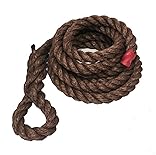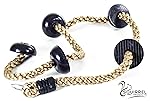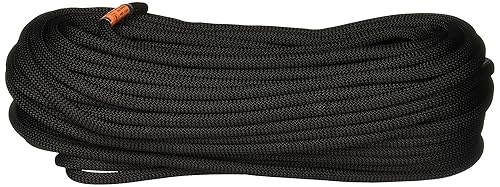Best Climbing Rope: 2018 Top Picks and Buying Guide
With plenty of choices for the best climbing rope, it can be challenging to choose one to purchase. From the materials used to the overall construction, there are many factors that will affect your decision.
The right choice of a climbing rope will depend on a number of things, such as local conditions and climbing style. There is no universal answer when it comes to which one is best because individual preferences and conditions will be critical.
If you are having a hard time deciding which amongst the climbing ropes will be best for you, we are here to help you out. Keep on reading the rest of this post and we will help you become a well-informed buyer.
Product
|
Image
|
Price
|
Our Rating
| |
|---|---|---|---|---|
 |
$-$$$
| |||
 |
$$$
| |||
 |
$$-$$$
| |||
 |
$$
| |||
 |
$$-$$$
|
Best Climbing Rope: 2018 Top Picks and Buying Guide
Our Top Picks for the Best Climbing Rope
Do not make things any harder for you! Below are the five products that should be on your radar, as well as some of the reasons why they are hard to match.
1. Ravenox Natural Twisted Cotton Rope

One of the things that you will love the most is the diverse selection of the available colors. For this reason, it is also versatile and can be used even in a number of art projects.
In terms of construction, the manufacturer notes that this is a triple-strand twisted cotton rope. Cotton is an excellent material because it is soft to the touch. However, take note that it can be prone to shrinkage after washing. The rope is soft, despite the fact that the durability is hard to rival.
You will enjoy tons of color choices should you decide to choose this rope over others. The diameter ranges from ¼ to one inch. Meanwhile, the minimum tensile strength is 750 pounds and the maximum tensile strength is 3,000 pounds.
Pros:
Cons:
Overall
This rope offers versatile applications and is available in a range of vibrant colors. It is triple-strand twisted and the main material is cotton, which also makes it great when it comes to softness.
2. Singing Rock R44 NFPA Static Rope

While it is quite expensive, this is a climbing rope that you should include on your list. It is a Type A rope, which means that it is rated for general use. Even when building a temporary shelter, you can use this rope, especially because tying a knot will be easy.
It is also a good thing that the rope offers minimal stretch, which will make it a great option for climbing. This is unlike in the case of other ropes that can stretch excessively, and hence, such will have a negative impact in its longevity.
To add, this rope is also notable because of the technology dubbed as Route 44, which has been exclusively developed by Singing Rock. The latter provides the rope with excellent bending properties, making it one of the strongest ropes on the market.
Pros:
Cons:
Overall
The high price of this climbing rope can be justified by its quality, especially with the patented Route 44 technology, which is responsible for allowing it to be durable.
3. RopeFit Outdoor/Indoor Manila Gym Climbing Rope

With a diameter of 1.5 inches, this is another popular choice for those who are looking for a climbing rope that comes with a premium construction. It can be used both indoors and outdoors.
Based on the technical details from the manufacturer, it has a breaking strength if 16,000 pounds.
The quality of this rope will be hard to rival, which is basically because it is hand-made. It is made by certified rope riggers in the U.S., so you can be confident about its performance. Plus, it is used even by the U.S. military, which should be more than enough to provide you with peace of mind.
The rope is also great because of the hand-spliced knotting loop, which is one of the reasons why it is user-friendly. Aside from being effortless to knot, this also eliminates the need to have a mounting bracket.
Pros:
Cons:
Overall
This rope has a regulation diameter of 1.5 inches. It is rugged and hand-made. The maximum breaking strength is rated at 16,000 pounds.
4. Squirrel Products Climbing Rope with Platforms

This is one of the most affordable from the five products that are mentioned in this post. However, it should be noted that this rope is made with the needs of kids in mind. For adults, the rope is not recommended as it can easily break.
The length of the rope is 78 inches. Meanwhile, there are plastic round platforms for hanging. It is made of plastic, and there were some complaints with regards to its durability. The platforms are four inches, which are big enough for climbing. They are spaced 13 inches apart from each other. At the end of the rope, meanwhile, there is a metal ring for hanging.
The surface of the rope soft enough to protect the delicate hands of its little users. This means that there will be no rope burn or chafing.
Pros:
Cons:
Overall
Strong yet soft – this is what you can expect from this climbing rope, which is made specifically for children. There are 4-inch climbing platforms that are spaced at 13 inches away from each other.
5. USA-Made Gym Climbing Rope

Value for money – this is what you can expect from this climbing rope. It is not the cheapest, but for the quality that it can deliver, the price is pretty much worth it.
It is important to note that the ropes are hand-crafted. This means that there is attention even to the smallest details, which will ensure its exceptional quality.
In terms of the material that is used, this is 100% Black Poly Dac. To add, it has the innovative 3M military-grade heat shrink, which allows the rope to maintain its structural integrity even after a long time of use.
Pros:
Cons:
Overall
This rope is hand-crafted in the U.S. and has a revolutionary technology for heat shrinking, providing an assurance that it will be able to withstand the test of time.
Different Types of Climbing Ropes
As you try to choose a climbing rope, it is important to know that there are different types available, including those that will be briefly mentioned below:
Essential Factors to Consider
To help you weigh the pros and cons from the possibilities, below are some of the most important factors to take into account.
Diameter
Through the years, climbing ropes have been thinner. Nonetheless, despite being skinnier, they utilize innovative materials to make sure that their durability is not compromised in any way. Often, the diameter ranges from eight to 10.5mm. If you want sturdier ropes, you should choose those with a larger diameter, especially if you will use it for top-roping.
Length
The standard length of a climbing rope is 60 meters. The right choice of length, however, will depend on a number of things, such as where you will climb. For indoor climbing ropes, 35 meters will be enough. For outdoor climbing, on the other hand, the length should be double the height of whatever it is that you intend to climb.
Weight
You might end up being uncomfortable when you are climbing with a heavy rope. This will also compromise its portability. However, despite being lightweight, the rope needs to be strong. The diameter and length of the rope will have a direct impact on its weight.
Construction
To understand the overall construction of the climbing rope, you should know that it consists of two main parts. One of these parts is called the core, which essentially refers to what is in the middle. These are tiny fibers that are coiled to each other. The integral strength of a single fiber strand is combined with other strands to provide structural integrity to the rope. The twisting of the core is also the one that is responsible for the energy absorption and stretchiness.
The second part is the sheath or the mantle. Basically, it refers to the part that covers the core. This is the part of the rope that your hand directly touches. This is also the one that is responsible for the visuals of the rope. The sheath should be constructed in such a way that it won’t cause splinters or chafes.
Speaking of construction, there are some climbing ropes that undergo treatments using innovative procedures, such as for waterproofing. This is important because when the rope is wet, there is a high chance that the structural integrity will suffer.
Certification
This is important because this is what will provide you with peace of mind. The most important for the rope is to have a certification from the UIAA. It stands for Union Internationale Des Associations D’Alpinisme, an international organization that develops global standards to prevent failure in climbing or mountaineering. With a certification, this means that the product has been through rigorous tests, which should be more than enough to provide you with peace of mind.
You should take a look at the UIAA Fall Rating of the rope, which basically refers to the ability of the rope to absorb energy in case of a fall. Aside from the fall rating, the dynamic elongation, working elongation, sheath slippage, and impact force are also all considered before issuing a certification to a specific product.
Taking Care of your Climbing Rope
Before we end this post, allow us to leave you some tips on the care and maintenance of climbing ropes. It is important that you pay attention to these things to prolong the rope and for your safety:
Wrap Up
Not all climbing ropes are created the same. From their length to their diameter to their impact force, there are several factors that will make one better than the other. To avoid regrets, keep an eye on the five ropes mentioned above, and you are guaranteed to enjoy the highest level of satisfaction.


Nhận xét
Đăng nhận xét